On the Free Vibrations of Non-Classically Damped Locally Resonant Metamaterial Plates
Abstract
:1. Introduction
2. Dynamic-Stiffness Model
3. Contour-Integral Algorithm
- Select a circle on the complex plane with centre and radius with ;
- Compute two complex random source matrices and having dimensions , being the size of the dynamic-stiffness matrix in Equation (18) and the number of source vectors collected in and ;
- Compute the shifted and scaled moments using the -point trapezoidal rule:with K the maximum moment degree considered for the moment and the Hermitian transpose of ;
- Construct the Hankel matrices and such that:
- Perform the singular-value decomposition of ;
- Omit small singular-value components ; set the number of remaining singular value components ; construct and extracting the principal submatrix with maximum index from and , i.e.,
- Compute the eigenvalues of the linear pencil:
- Calculate the eigenvalues:
4. Frequency Response
5. Numerical Applications
6. Discussion
Author Contributions
Funding
Data Availability Statement
Conflicts of Interest
Abbreviations
| BC | Boundary condition |
| DOF | Degree of freedom |
| FE | Finite element |
| LRMP | Locally resonant metamaterial plate |
Appendix A. Eigenvalues
| Mode | Eigenvalue () (DS) | Eigenvalue () (FE) |
|---|---|---|
| 1 | ||
| 2 | ||
| 3 | ||
| 4 | ||
| 5 | ||
| 6 | ||
| 7 | ||
| 8 | ||
| 9 | ||
| 10 | ||
| 11 | ||
| 12 | ||
| 13 | ||
| 14 | ||
| 15 | ||
| 16 | ||
| 17 | ||
| 18 | ||
| 19 | ||
| 20 | ||
| 21 | ||
| 22 | ||
| 23 | ||
| 24 | ||
| 25 | ||
| 26 | ||
| 27 | ||
| 28 | ||
| 29 | ||
| 30 | ||
| 31 | ||
| 32 | ||
| 33 | ||
| 34 | ||
| 35 | ||
| 36 | ||
| 37 | ||
| 38 | ||
| 39 | ||
| 40 | ||
| 41 | ||
| 42 | ||
| 43 | ||
| 44 | ||
| 45 | ||
| 46 | ||
| 47 | ||
| 48 | ||
| 49 | ||
| 50 |
| Mode | Eigenvalue () (DS) | Eigenvalue () (FE) |
|---|---|---|
| 51 | ||
| 52 | ||
| 53 | ||
| 54 | ||
| 55 | ||
| 56 | ||
| 57 | ||
| 58 | ||
| 59 | ||
| 60 | ||
| 61 | ||
| 62 | ||
| 63 | ||
| 64 | ||
| 65 | ||
| 66 | ||
| 67 | ||
| 68 | ||
| 69 | ||
| 70 | ||
| 71 | ||
| 72 | ||
| 73 | ||
| 74 | ||
| 75 | ||
| 76 | ||
| 77 | ||
| 78 | ||
| 79 | ||
| 80 | ||
| 81 | ||
| 82 | ||
| 83 | ||
| 84 | ||
| 85 | ||
| 86 | ||
| 87 | ||
| 88 | ||
| 89 | ||
| 90 | ||
| 91 | ||
| 92 | ||
| 93 | ||
| 94 | ||
| 95 | ||
| 96 | ||
| 97 | ||
| 98 | ||
| 99 | ||
| 100 |
| Mode | Eigenvalue () (DS) | Eigenvalue () (FE) |
|---|---|---|
| 101 | ||
| 102 | ||
| 103 | ||
| 104 | ||
| 105 | ||
| 106 | ||
| 107 | ||
| 108 | ||
| 109 | ||
| 110 | ||
| 111 | ||
| 112 | ||
| 113 | ||
| 114 | ||
| 115 | ||
| 116 | ||
| 117 | ||
| 118 | ||
| 119 | ||
| 120 | ||
| 121 | ||
| 122 | ||
| 123 | ||
| 124 | ||
| 125 | ||
| 126 | ||
| 127 | ||
| 128 | ||
| 129 | ||
| 130 | ||
| 131 | ||
| 132 | ||
| 133 | ||
| 134 | ||
| 135 | ||
| 136 | ||
| 137 | ||
| 138 | ||
| 139 | ||
| 140 | ||
| 141 | ||
| 142 | ||
| 143 | ||
| 144 | ||
| 145 | ||
| 146 | ||
| 147 | ||
| 148 | ||
| 149 | ||
| 150 |
References
- Xiao, Y.; Wen, J.; Wen, X. Sound transmission loss of metamaterial-based thin plates with multiple subwavelength arrays of attached resonators. J. Sound Vib. 2012, 331, 5408–5423. [Google Scholar] [CrossRef]
- Xiao, Y.; Wen, J.; Yu, D.; Wen, X. Flexural wave propagation in beams with periodically attached vibration absorbers: Band-gap behavior and band formation mechanisms. J. Sound Vib. 2013, 332, 867–893. [Google Scholar] [CrossRef]
- Xiao, Y.; Wen, J.; Huang, L.; Wen, X. Analysis and experimental realization of locally resonant phononic plates carrying a periodic array of beam-like resonators. J. Phys. Appl. Phys. 2013, 47, 045307. [Google Scholar] [CrossRef]
- Peng, H.; Pai, P.F.; Deng, H. Acoustic multi-stopband metamaterial plates design for broadband elastic wave absorption and vibration suppression. Int. J. Mech. Sci. 2015, 103, 104–114. [Google Scholar] [CrossRef]
- He, Z.C.; Xiao, X.; Li, E. Design for structural vibration suppression in laminate acoustic metamaterials. Compos. Part B Eng. 2017, 131, 237–252. [Google Scholar] [CrossRef] [Green Version]
- Wang, T.; Sheng, M.; Guo, Z.; Qin, Q. Acoustic characteristics of damped metamaterial plate with parallel attached resonators. Arch. Mech. 2017, 69, 29–52. [Google Scholar]
- Gao, P.; Climente, A.; Sánchez-Dehesa, J.; Wu, L. Single-phase metamaterial plates for broadband vibration suppression at low frequencies. J. Sound Vib. 2019, 444, 108–126. [Google Scholar] [CrossRef]
- Miranda, E., Jr.; Nobrega, E.; Ferreira, A.; Dos Santos, J. Flexural wave band gaps in a multi-resonator elastic metamaterial plate using Kirchhoff-Love theory. Mech. Syst. Signal Process. 2019, 116, 480–504. [Google Scholar] [CrossRef]
- Xiao, X.; He, Z.C.; Li, E.; Cheng, A.G. Design multi-stopband laminate acoustic metamaterials for structural-acoustic coupled system. Mech. Syst. Signal Process. 2019, 115, 418–433. [Google Scholar] [CrossRef] [Green Version]
- Wang, T. Tunable band gaps in an inertant metamaterial plate with two-degree-of-freedom local resonance. Phys. Lett. A 2020, 384, 126420. [Google Scholar] [CrossRef]
- Song, Y.; Wen, J.; Tian, H.; Lu, X.; Li, Z.; Feng, L. Vibration and sound properties of metamaterial sandwich panels with periodically attached resonators: Simulation and experiment study. J. Sound Vib. 2020, 489, 115644. [Google Scholar] [CrossRef]
- Li, J.; Fan, X.; Li, F. Numerical and experimental study of a sandwich-like metamaterial plate for vibration suppression. Compos. Struct. 2020, 238, 111969. [Google Scholar] [CrossRef]
- Wang, Q.; Li, J.; Zhang, Y.; Xue, Y.; Li, F. Bandgap properties in metamaterial sandwich plate with periodically embedded plate-type resonators. Mech. Syst. Signal Process. 2021, 151, 107375. [Google Scholar] [CrossRef]
- Boscolo, M.; Banerjee, J. Dynamic stiffness elements and their applications for plates using first order shear deformation theory. Comput. Struct. 2011, 89, 395–410. [Google Scholar] [CrossRef]
- Boscolo, M.; Banerjee, J. Dynamic stiffness formulation for composite Mindlin plates for exact modal analysis of structures. Part I: Theory. Comput. Struct. 2012, 96, 61–73. [Google Scholar] [CrossRef]
- Boscolo, M.; Banerjee, J.R. Dynamic stiffness formulation for composite Mindlin plates for exact modal analysis of structures. Part II: Results and applications. Comput. Struct. 2012, 96–97, 74–83. [Google Scholar] [CrossRef] [Green Version]
- Banerjee, J.; Papkov, S.; Liu, X.; Kennedy, D. Dynamic stiffness matrix of a rectangular plate for the general case. J. Sound Vib. 2015, 342, 177–199. [Google Scholar] [CrossRef]
- Liu, X.; Banerjee, J. An exact spectral-dynamic stiffness method for free flexural vibration analysis of orthotropic composite plate assemblies—Part I: Theory. Compos. Struct. 2015, 132, 1274–1287. [Google Scholar] [CrossRef] [Green Version]
- Liu, X.; Banerjee, J.R. An exact spectral-dynamic stiffness method for free flexural vibration analysis of orthotropic composite plate assemblies—Part II: Applications. Compos. Struct. 2015, 132, 1288–1302. [Google Scholar] [CrossRef] [Green Version]
- Liu, X.; Banerjee, J. Free vibration analysis for plates with arbitrary boundary conditions using a novel spectral-dynamic stiffness method. Comput. Struct. 2016, 164, 108–126. [Google Scholar] [CrossRef] [Green Version]
- Liu, X.; Kassem, H.; Banerjee, J. An exact spectral dynamic stiffness theory for composite plate-like structures with arbitrary non-uniform elastic supports, mass attachments and coupling constraints. Compos. Struct. 2016, 142, 140–154. [Google Scholar] [CrossRef] [Green Version]
- Wittrick, W.; Williams, F. A general algorithm for computing natural frequencies of elastic structures. Q. J. Mech. Appl. Math. 1971, 24, 263–284. [Google Scholar] [CrossRef]
- Russillo, A.F.; Failla, G. On the free vibrations of locally-resonant structures. Comput. Struct. 2020, 241, 106356. [Google Scholar] [CrossRef]
- Hussein, M.I.; Leamy, M.J.; Ruzzene, M. Dynamics of phononic materials and structures: Historical origins, recent progress, and future outlook. Appl. Mech. Rev. 2014, 66, 040802. [Google Scholar] [CrossRef]
- Sakurai, T.; Sugiura, H. A projection method for generalized eigenvalue problems using numerical integration. J. Comput. Appl. Math. 2003, 159, 119–128. [Google Scholar] [CrossRef]
- Asakura, J.; Sakurai, T.; Tadano, H.; Ikegami, T.; Kimura, K. A numerical method for nonlinear eigenvalue problems using contour integrals. JSIAM Lett. 2009, 1, 52–55. [Google Scholar] [CrossRef] [Green Version]
- Ikegami, T.; Sakurai, T.; Nagashima, U. A filter diagonalization for generalized eigenvalue problems based on the Sakurai–Sugiura projection method. J. Comput. Appl. Math. 2010, 233, 1927–1936. [Google Scholar] [CrossRef] [Green Version]
- Sakurai, T.; Futamura, Y.; Tadano, H. Efficient Parameter Estimation and Implementation of a Contour Integral-Based Eigensolver. J. Algorithms Comput. Technol. 2013, 7, 249–269. [Google Scholar] [CrossRef]
- Russillo, A.F.; Failla, G.; Fraternali, F. Free and forced vibrations of damped locally-resonant sandwich beams. Eur. J. Mech.—A/Solids 2021, 86, 104188. [Google Scholar] [CrossRef]
- Failla, G.; Santoro, R.; Burlon, A.; Russillo, A.F. An exact approach to the dynamics of locally-resonant beams. Mech. Res. Commun. 2020, 103, 103460. [Google Scholar] [CrossRef]
- Russillo, A.F.; Failla, G. A novel reduced-order dynamic-stiffness formulation for locally resonant metamaterial plates. Compos. Struct. 2022, 280, 114811. [Google Scholar] [CrossRef]
- Åberg, M.; Gudmundson, P. The usage of standard finite element codes for computation of dispersion relations in materials with periodic microstructure. J. Acoust. Soc. Am. 1997, 102, 2007–2013. [Google Scholar] [CrossRef]
- Hsu, J.C.; Lin, F.S. Measurement of locally resonant band gaps in a surface phononic crystal with inverted conical pillars. Jpn. J. Appl. Phys. 2018, 57, 07LB01. [Google Scholar] [CrossRef]
- Yudistira, D.; Boes, A.; Graczykowski, B.; Alzina, F.; Yeo, L.Y.; Sotomayor Torres, C.M.; Mitchell, A. Nanoscale pillar hypersonic surface phononic crystals. Phys. Rev. B 2016, 94, 094304. [Google Scholar] [CrossRef] [Green Version]
- Guo, Y.; Schubert, M.; Dekorsy, T. Finite element analysis of surface modes in phononic crystal waveguides. J. Appl. Phys. 2016, 119, 124302. [Google Scholar] [CrossRef] [Green Version]
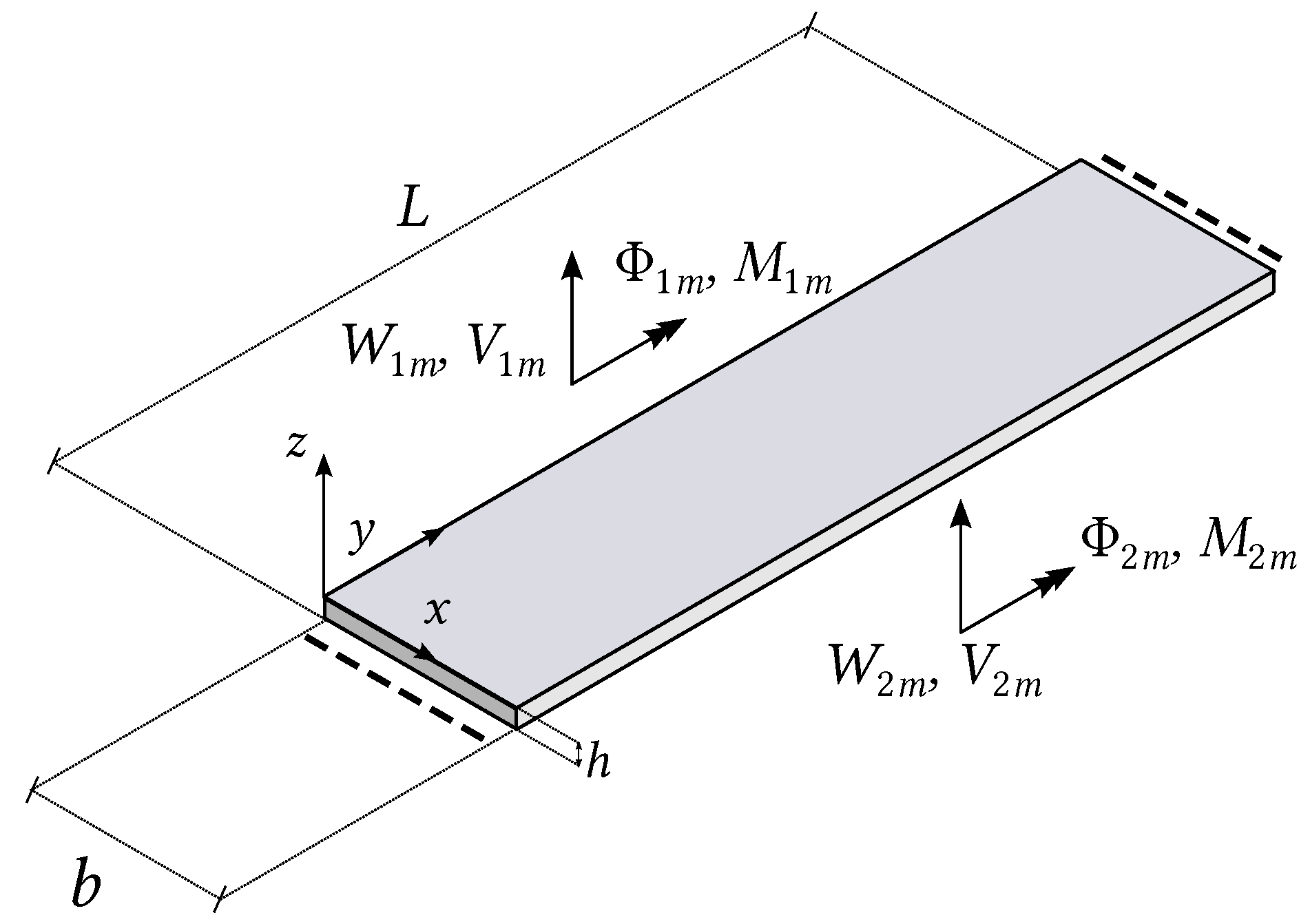

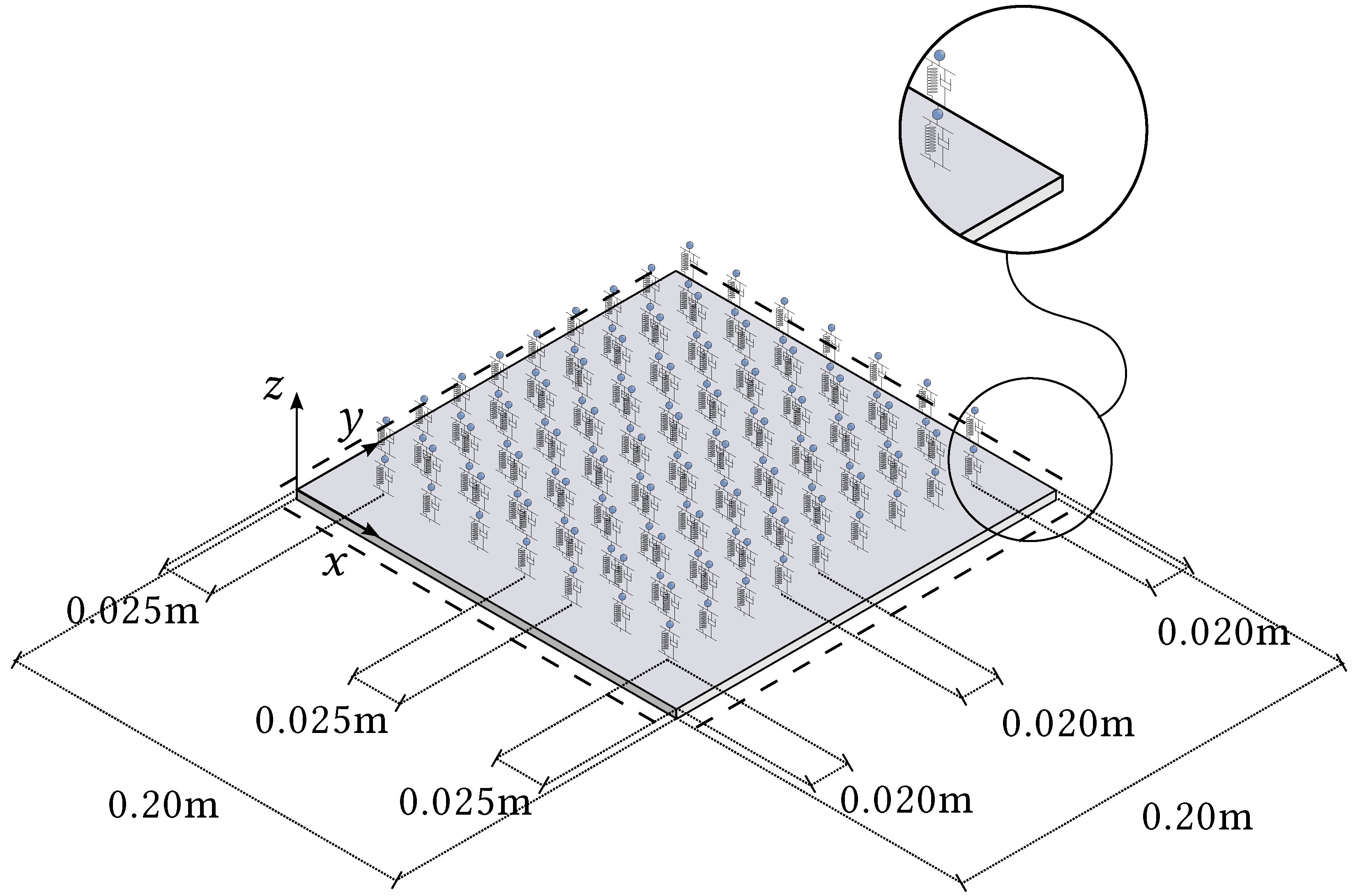

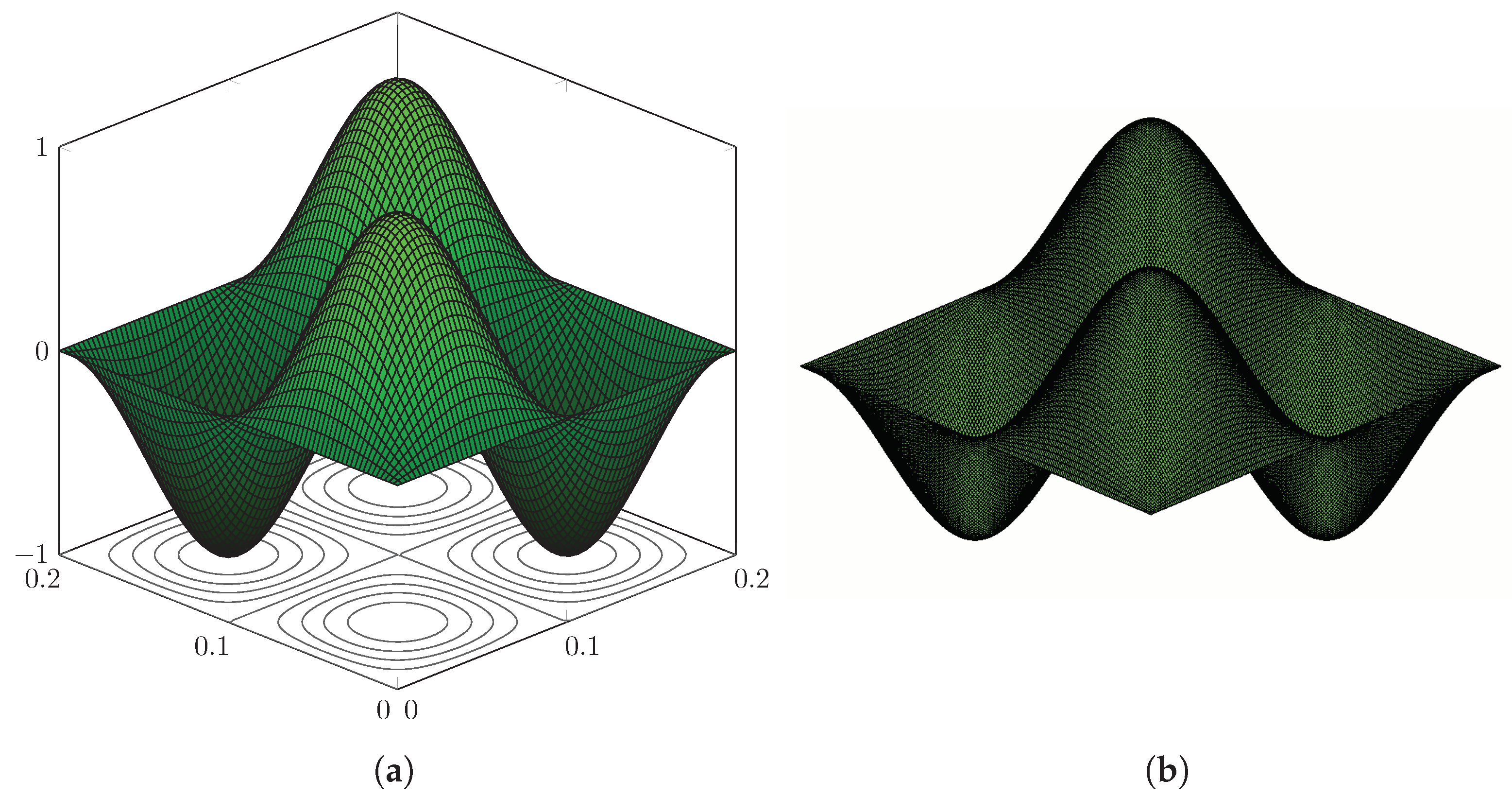
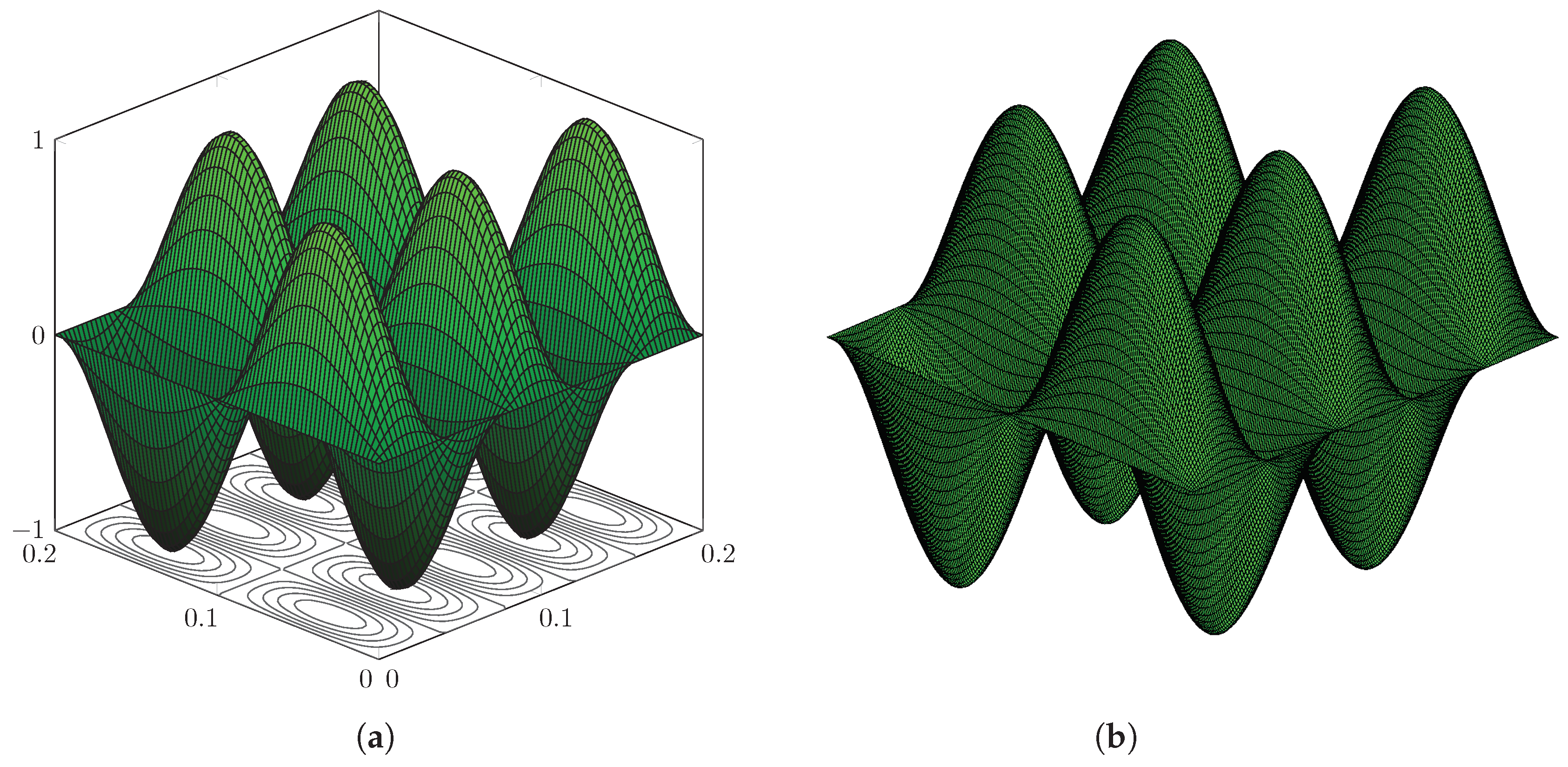
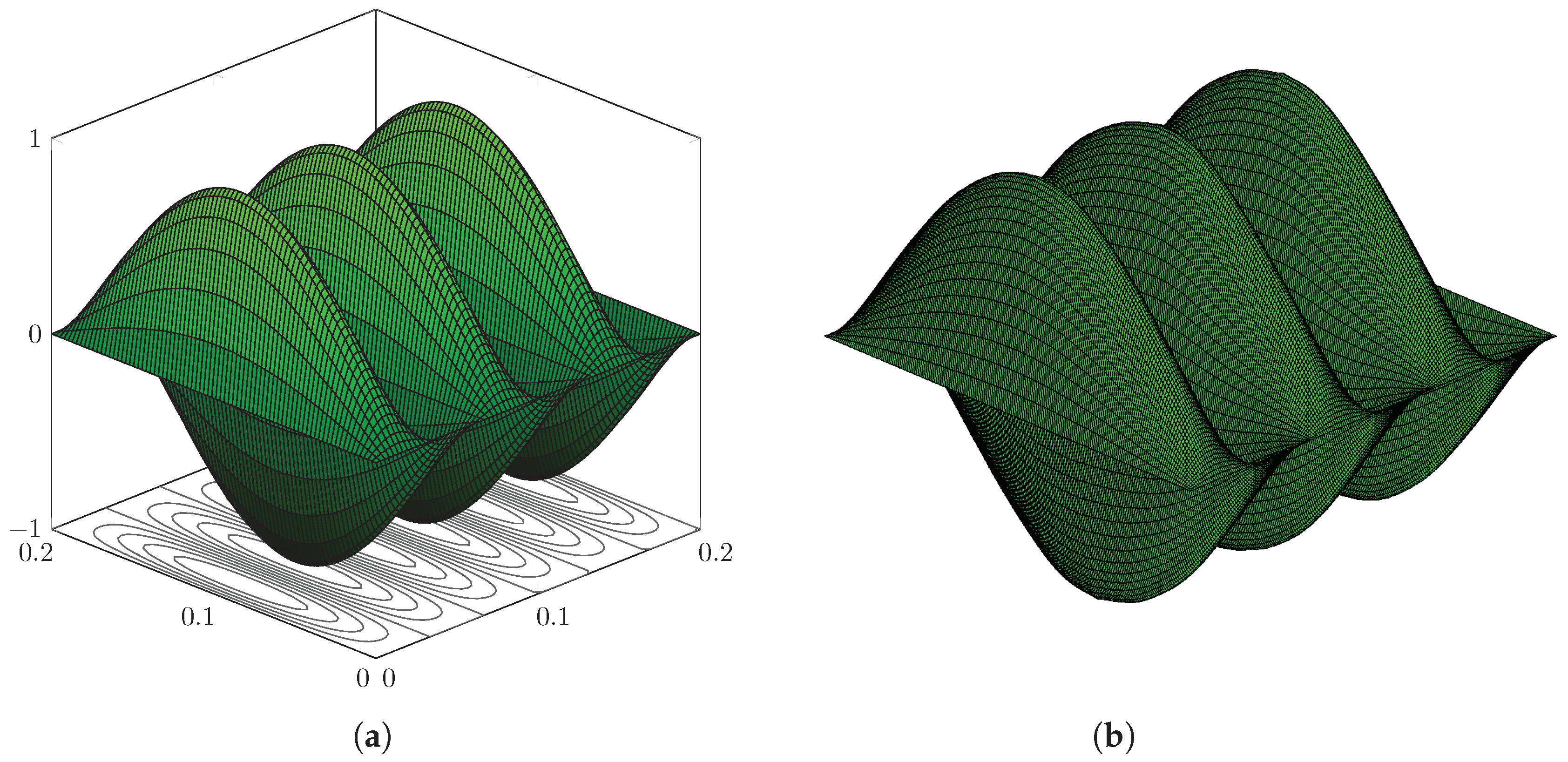
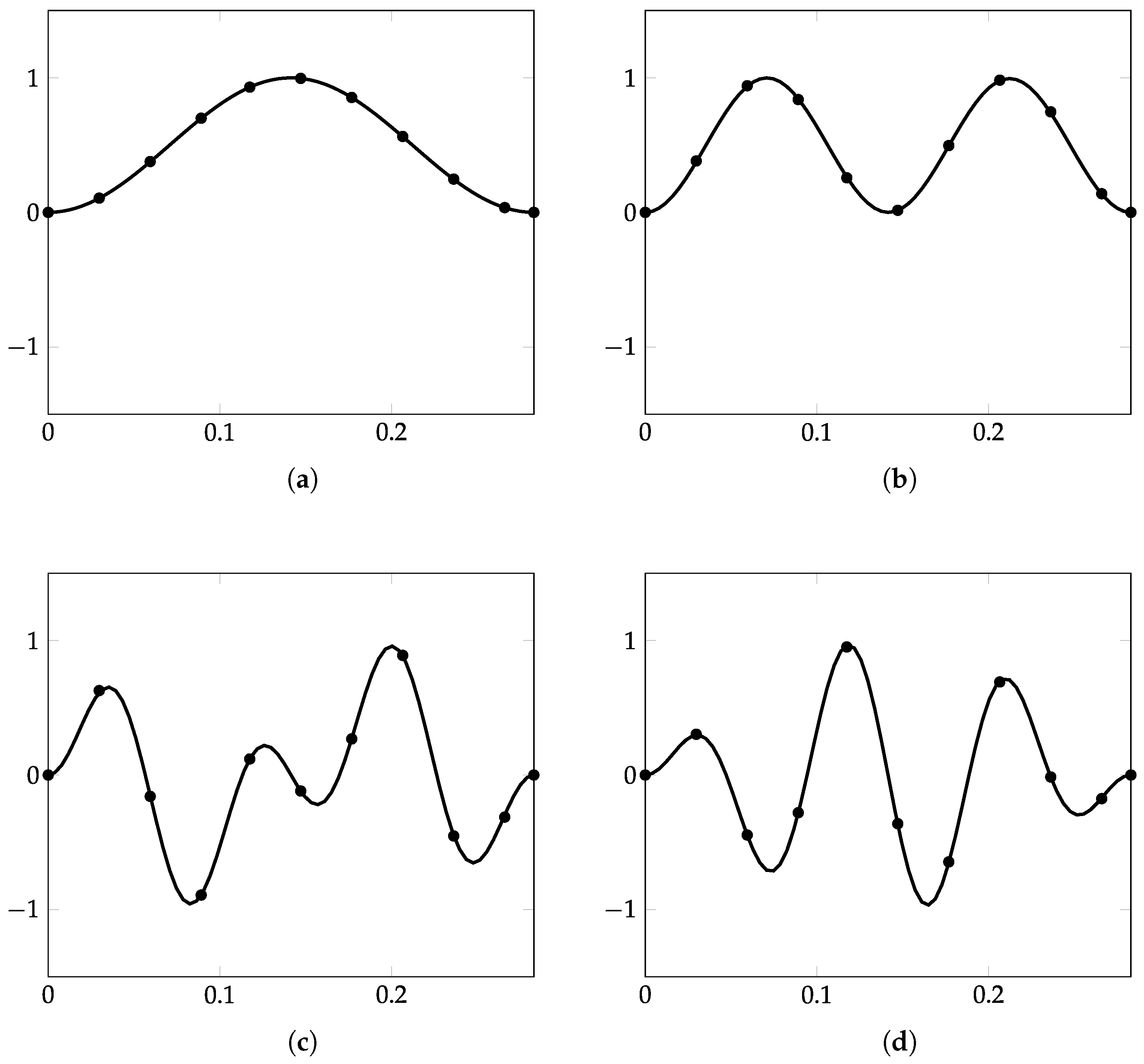
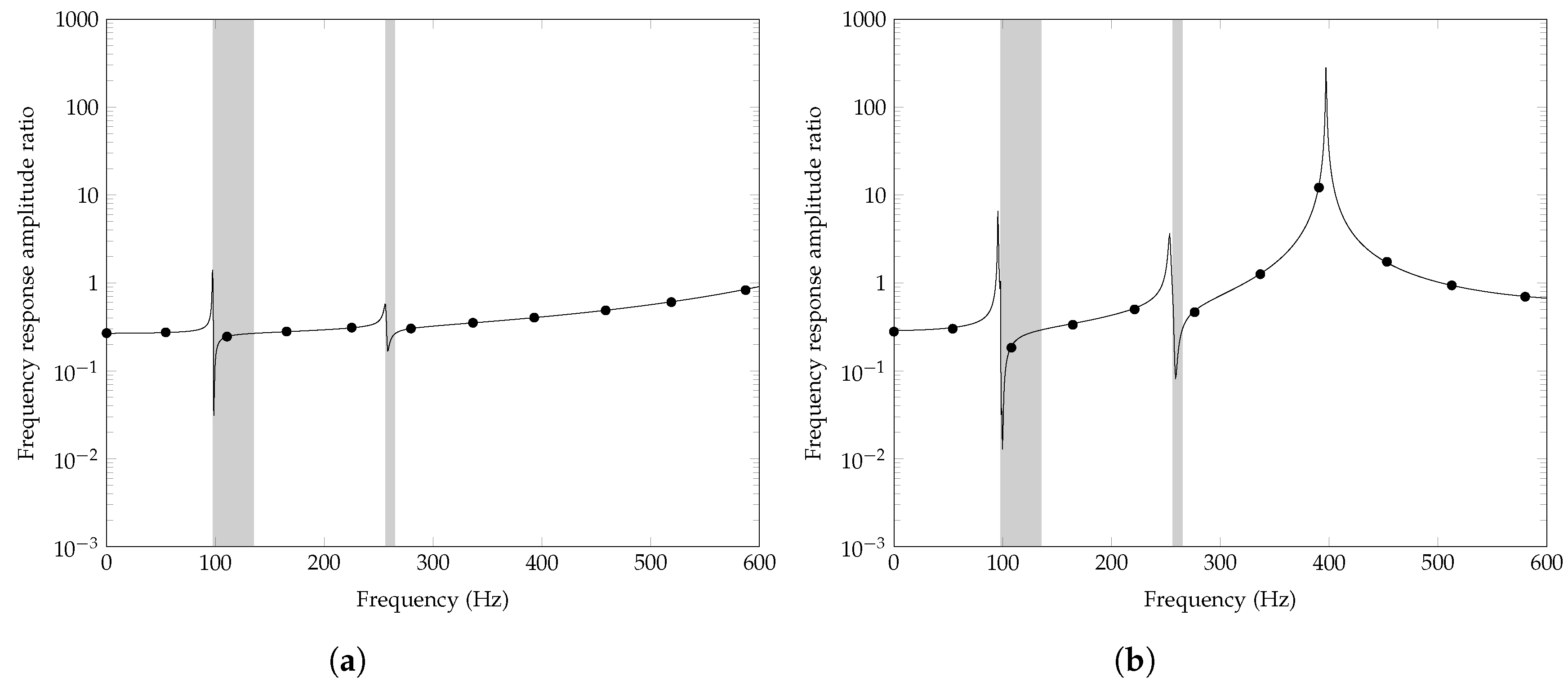
| Mode | Eigenvalue () (DS) | Eigenvalue () (FE) |
|---|---|---|
| 1 | ||
| 2 | ||
| 3 | ||
| 4 | ||
| 5 | ||
| 6 | ||
| 7 | ||
| 8 | ||
| 9 | ||
| 10 | ||
| 11 | ||
| 12 | ||
| 13 | ||
| 14 | ||
| 15 | ||
| ⋮ | ⋮ | ⋮ |
| 90 | ||
| 91 | ||
| 92 | ||
| 93 | ||
| 94 | ||
| 95 | ||
| 96 | ||
| 97 | ||
| 98 | ||
| 99 | ||
| 100 | ||
| ⋮ | ⋮ | ⋮ |
| 135 | ||
| 136 | ||
| 137 | ||
| 138 | ||
| 139 | ||
| 140 | ||
| 141 | ||
| 142 | ||
| 143 | ||
| 144 | ||
| 145 | ||
| 146 | ||
| 147 | ||
| 148 | ||
| 149 | ||
| 150 |
Publisher’s Note: MDPI stays neutral with regard to jurisdictional claims in published maps and institutional affiliations. |
© 2022 by the authors. Licensee MDPI, Basel, Switzerland. This article is an open access article distributed under the terms and conditions of the Creative Commons Attribution (CC BY) license (https://creativecommons.org/licenses/by/4.0/).
Share and Cite
Russillo, A.F.; Failla, G.; Amendola, A.; Luciano, R. On the Free Vibrations of Non-Classically Damped Locally Resonant Metamaterial Plates. Nanomaterials 2022, 12, 541. https://doi.org/10.3390/nano12030541
Russillo AF, Failla G, Amendola A, Luciano R. On the Free Vibrations of Non-Classically Damped Locally Resonant Metamaterial Plates. Nanomaterials. 2022; 12(3):541. https://doi.org/10.3390/nano12030541
Chicago/Turabian StyleRussillo, Andrea Francesco, Giuseppe Failla, Ada Amendola, and Raimondo Luciano. 2022. "On the Free Vibrations of Non-Classically Damped Locally Resonant Metamaterial Plates" Nanomaterials 12, no. 3: 541. https://doi.org/10.3390/nano12030541
APA StyleRussillo, A. F., Failla, G., Amendola, A., & Luciano, R. (2022). On the Free Vibrations of Non-Classically Damped Locally Resonant Metamaterial Plates. Nanomaterials, 12(3), 541. https://doi.org/10.3390/nano12030541






